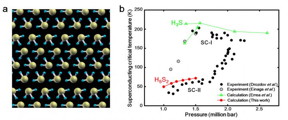Home > Press > Key compound for high-temperature superconductivity was found: Leading to the solution of environmental and energy problems with superconductivity
 |
| a. Crystal structure of the H5S2 compound predicted by genetic algorithm technique. The structure forms a mixed structure of H2S and H3S molecules. b. Comparison of superconducting critical temperature (Tc) among experimental and calculated results. The Tc value calculated for H5S2 shows a good agreement with the experimental data of the superconducting phase II (SC-II). CREDIT: Osaka University |
Abstract:
A research group in Japan found a new compound H5S2 that shows a new superconductivity phase on computer simulation. Further theoretical and experimental research based on H5S2 predicted by this group will lead to the clarification of the mechanism behind high-temperature superconductivity, which takes place in hydrogen sulfide .
Key compound for high-temperature superconductivity was found: Leading to the solution of environmental and energy problems with superconductivity
Osaka, Japan | Posted on June 17th, 2016Superconductivity is the total disappearance of electrical resistance when an object is cooled below a definite temperature. If superconductor is used for electric wire, it becomes possible to carry electricity without loss. That's why superconductivity has been drawing attention as an important physical phenomenon for solving environmental and energy problems.
However, the superconducting critical temperature, the temperature at which superconductivity takes place, is so low that its practical realization is difficult. Last year, a striking news came out that H2S broke the record for superconducting critical temperature under high-pressure. However, the chemical composition ratio of sulfur and hydrogen and the crystal structure during the process in which superconductivity takes place have not been well understood.
A research group led by Takahiro Ishikawa, Specially Appointed Assistant Professor, and Katsuya Shimizu, Professor, at Center for Science and Technology under Extreme Conditions, Graduate School of Engineering Science, Osaka University, Tatsuki Oda, Professor at School of Mathematics and Physics, Kanazawa University, and Naoshi Suzuki, Professor at Faculty of Engineering Science, Kansai University predicted a new superconductivity phase of hydrogen sulfide (H5S2), which was presented at a pressure of 1.1 million bar on computer simulation. The superconducting critical temperature obtained from H5S2, whose calculated value was the same as the experimental value. This result may lead to the clarification of the mechanism behind high-temperature superconductivity, which takes place in hydrogen sulfide by further theoretical and experimental research based on H5S2.
Furthermore, by applying methods used and knowledge obtained by this group to other light element hydrides, it will become possible to establish guidelines for enhancing superconducting critical temperature to near room temperature.
This research was featured in the electronic version of Scientific Reports on Thursday, March 17, 2016
####
For more information, please click here
Contacts:
Saori Obayashi
81-661-055-886
Copyright © Osaka University
If you have a comment, please Contact us.Issuers of news releases, not 7th Wave, Inc. or Nanotechnology Now, are solely responsible for the accuracy of the content.
| Related Links |
| Related News Press |
Superconductivity
News and information
![]() Researchers develop molecular qubits that communicate at telecom frequencies October 3rd, 2025
Researchers develop molecular qubits that communicate at telecom frequencies October 3rd, 2025
![]() Next-generation quantum communication October 3rd, 2025
Next-generation quantum communication October 3rd, 2025
![]() "Nanoreactor" cage uses visible light for catalytic and ultra-selective cross-cycloadditions October 3rd, 2025
"Nanoreactor" cage uses visible light for catalytic and ultra-selective cross-cycloadditions October 3rd, 2025
Possible Futures
![]() Spinel-type sulfide semiconductors to operate the next-generation LEDs and solar cells For solar-cell absorbers and green-LED source October 3rd, 2025
Spinel-type sulfide semiconductors to operate the next-generation LEDs and solar cells For solar-cell absorbers and green-LED source October 3rd, 2025
Discoveries
![]() Researchers develop molecular qubits that communicate at telecom frequencies October 3rd, 2025
Researchers develop molecular qubits that communicate at telecom frequencies October 3rd, 2025
![]() Next-generation quantum communication October 3rd, 2025
Next-generation quantum communication October 3rd, 2025
![]() "Nanoreactor" cage uses visible light for catalytic and ultra-selective cross-cycloadditions October 3rd, 2025
"Nanoreactor" cage uses visible light for catalytic and ultra-selective cross-cycloadditions October 3rd, 2025
Announcements
![]() Rice membrane extracts lithium from brines with greater speed, less waste October 3rd, 2025
Rice membrane extracts lithium from brines with greater speed, less waste October 3rd, 2025
![]() Researchers develop molecular qubits that communicate at telecom frequencies October 3rd, 2025
Researchers develop molecular qubits that communicate at telecom frequencies October 3rd, 2025
![]() Next-generation quantum communication October 3rd, 2025
Next-generation quantum communication October 3rd, 2025
![]() "Nanoreactor" cage uses visible light for catalytic and ultra-selective cross-cycloadditions October 3rd, 2025
"Nanoreactor" cage uses visible light for catalytic and ultra-selective cross-cycloadditions October 3rd, 2025
Interviews/Book Reviews/Essays/Reports/Podcasts/Journals/White papers/Posters
![]() Spinel-type sulfide semiconductors to operate the next-generation LEDs and solar cells For solar-cell absorbers and green-LED source October 3rd, 2025
Spinel-type sulfide semiconductors to operate the next-generation LEDs and solar cells For solar-cell absorbers and green-LED source October 3rd, 2025
![]() Rice membrane extracts lithium from brines with greater speed, less waste October 3rd, 2025
Rice membrane extracts lithium from brines with greater speed, less waste October 3rd, 2025
|
|
||
|
|
||
| The latest news from around the world, FREE | ||
|
|
||
|
|
||
| Premium Products | ||
|
|
||
|
Only the news you want to read!
Learn More |
||
|
|
||
|
Full-service, expert consulting
Learn More |
||
|
|
||








